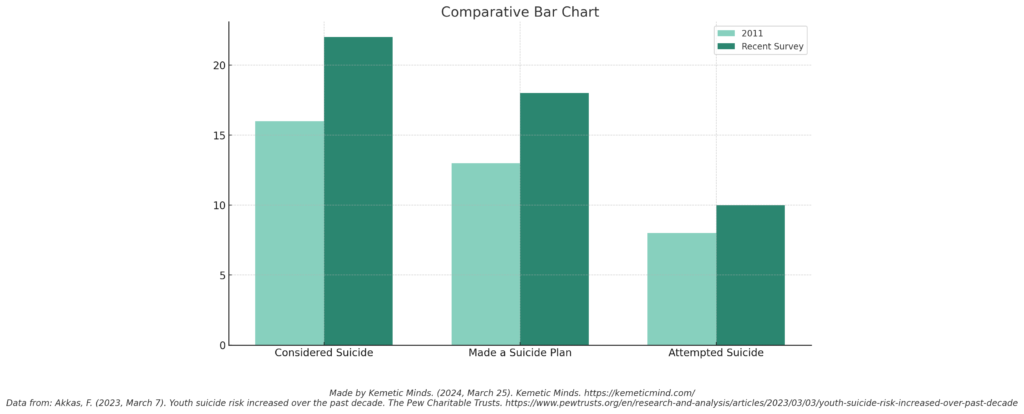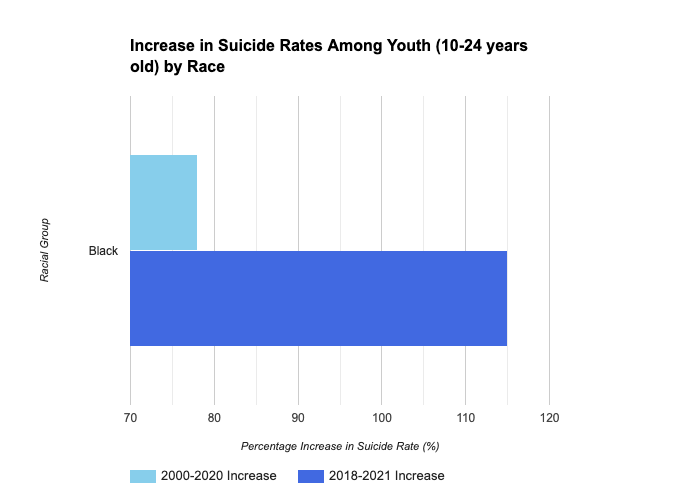Seeking Hope and Healing in a Troubled Time
Introduction
The rising suicide rates among Black youth signal a deep-seated crisis within our communities, one that demands urgent attention and action. This article delves into the complexities behind these troubling statistics, exploring underlying causes and highlighting effective strategies for intervention and support. By understanding the multifaceted nature of this issue, we can begin to reverse this distressing trend and pave the way towards healing and resilience.
Understanding the Crisis

The increase in suicide rates among Black youth is not just a statistical anomaly; it’s a reflection of systemic issues, historical, social science, and relationship dynamics. Here are a few statistics to keep in mind regarding this subject.
Pew Research – In a recent survey, 22% of high school students reported having seriously contemplated suicide in the past year, an increase from 16% in 2011. Additionally, 18% of respondents had devised a suicide plan, while 10% had attempted suicide at least once, marking an uptick from the 13% and 8% reported a decade ago, respectively. The rise in suicide risk since 2011 was noted across all demographic categories, including various races, ethnicities, and genders, although some groups were identified as being at higher risk than others (Akkas, 2023).1
Here is a chart to help visualize this growing crisis, exacerbated by Covid19 crisis of 2020:

Another non-profit organization, the Association of American Medical Colleges (AAMC), highlighted the following:
Between 2018 and 2021, Black individuals aged 10-24 experienced the most significant rise in suicide rates, with a 37% increase. Additionally, from 2000 to 2020, there was a dramatic 78% increase in suicide rates among Black youth aged 10-19.2
To help visualize this statistic, we created two different data sets:


Several factors contribute to this alarming trend:
- Systemic Inequality: Persistent racial disparities in healthcare access and quality contribute to unaddressed mental health needs (Hill et al., 2023).3
- Stigma and Silence: Cultural stigmas around mental health within some Black communities can prevent young people from seeking help (Lcsw, 2020).4
- Trauma and Stress: Exposure to racial discrimination and violence exacerbates mental health issues, leading to feelings of hopelessness and despair.5
One major factor that affects young people in the black community is financial constraints to no fault of their own. The descendants of U.S. chattel slavery did not receive pay during the highest level of purchasing power in the U.S. dollar possessed.
Here is an excellent visual aid that puts the U.S. dollar purchasing power into perspective from The Visual Capitalist (Bhutada, 2021).6

Today’s youth do not have the level of advancement the prior generation had due to policies set in 1971 when the gold standard ended (Ghizoni, n.d.).7
If you add feelings of hopelessness, battling homelessness, income disparities, poverty, and a lack of a financial foundation and cushion, you have the results we all see today. Having solid finances plays a significant role in how one feels about the future.
Perdue wrote a short article that stated:
“The results indicated that finances are the No. 1 cause of stress (73%) – being reported as a major cause of stress more often than politics (59%), work (49%) and family (46%)” (Perdue Today, 2021, para.2).
The following chart shows the real median household income by race (U.S. Census)

Income, for a young man especially can change how you feel about yourself, how others view you, and how you perform. In America, materialism, financial status, and what you have can affect the entire environment that you live in. Social circles, peer pressure, and several factors can weigh on you, along with pressure.
According to a Pew research survey by Schaeffer (2022),” 70% of Americans said young adults today have a more challenging time buying a home than their parent’s generation did” (para, 1). 8
Having something to look forward to can play a significant role in your happiness, and without the hope of home ownership, it is understandable how one can feel wrong about the future. Again, the system established around the youth has molded many adverse outcomes that are no fault of their own.
If you look at the wealth comparison by race, wealth inequality is one of the ongoing issues that black people face in all age groups and ethnicities (Minds, 2023).9

Economic outcomes are pivotal to understanding the level of frustration that can build up in a young person in general. Financial troubles/setbacks can be cushioned with a wealth base formed from previous generations, and unfortunately, the descendants of U.S. chattel slavery have never received their just due.
You can not outwork the wealth that was stolen during the era when black people worked for free.
-Kemetic Mind
Some youth turn to illegal activities to compensate for the lack of opportunities, which can tear down opportunities for them in the future if they are caught. One event can turn a young person’s life into a tough, uphill battle.
So what are the solutions that can help our young people to avoid thinking these negative thoughts?
Identifying Solutions

Addressing this crisis requires a multifaceted approach centered on community support, financial, education, and policy reform:
- Community Engagement: Building robust support systems within communities can provide a safety net for vulnerable youth.
- Education and Awareness: Initiatives to destigmatize mental health issues and educate families and communities are crucial.
- Policy and Advocacy: Advocating for policy changes that ensure equitable access to mental health services is essential.
- A comprehensive reparations plan for specifically the descendants of U.S. chattel slavery.
I believe the layers of protection start in the home and create a healthy economic environment. This is why I advocate for reparations to descendants of enslaved people in my special report. ( Minds, 2023).
Through these efforts, we can create an environment where seeking help is encouraged and supported, and young Black individuals feel valued and understood.
Moving Forward: Hope and Action

Reversing the trend requires commitment from all sectors of society:
- Personal Stories: Sharing success stories of overcoming mental health challenges can inspire hope and action.
- Access to Resources: Ensuring that young people have access to mental health resources and culturally competent care is crucial.
- Community Programs: Implementing community-based programs focusing on resilience, coping strategies, and mental wellness can make a significant difference.
By fostering a culture of openness, support, and proactive mental health care, we can begin to dismantle the barriers that contribute to the crisis.
Conclusion
The rise in suicide rates among Black youth is a stark reminder of the urgent need for collective action. By understanding the underlying causes, advocating for systemic change, and providing compassionate support, we can change the narrative and offer hope to those in need. Let this be a call to action: to listen, support, and uplift the voices of Black youth as we strive for a future where every young person has the opportunity to thrive. The key is inspiring them and keeping their mind occupied with future hopes, goals, and tailor-made personal interests that keep their spirits high.
About the Author
He is a mental health advocate, aspiring numerologist, lifelong student, and writer who studies computer science.
Contact Information | Social Media Links
References
- Akkas, F. (2023, March 7). Youth suicide risk increased over the past decade. The Pew Charitable Trusts. https://www.pewtrusts.org/en/research-and-analysis/articles/2023/03/03/youth-suicide-risk-i. increased-over-past-decade
↩︎ - Sheftall, A. (2023, April 11). The tragedy of Black youth suicide. AAMC.
https://www.aamc.org/news/tragedy-black-youth-suicide ↩︎ - Hill, L., Ndugga, N., & Artiga, S. (2023, July 10). Key data on health and health care by race and Ethnicity | KFF. KFF.
https://www.kff.org/racial-equity-and-health-policy/report/key-data-on-health-and-health-care-by-race-and-ethnicity/ ↩︎ - Lcsw, A. M. (2020, October 26). Exploring the mental health stigma in Black communities. Verywell Mind.
https://www.verywellmind.com/exploring-the-mental-health-stigma-in-black-communities-5078964 ↩︎ - Tao X, Fisher CB. Exposure to Social Media Racial Discrimination and Mental Health among Adolescents of Color. J Youth Adolesc. 2022 Jan;51(1):30-44. doi: 10.1007/s10964-021-01514-z. Epub 2021 Oct 22. PMID: 34686952; PMCID: PMC8535107. ↩︎
- Bhutada, G. (2021, April 7). Purchasing power of the U.S. dollar over time. Visual Capitalist.
https://www.visualcapitalist.com/purchasing-power-of-the-u-s-dollar-over-time/ ↩︎ - Ghizoni, B. S. K. (n.d.). Nixon ends convertibility of U.S. dollars to gold and announces Wage/Price controls. Federal Reserve History.
https://www.federalreservehistory.org/essays/gold-convertibility-ends ↩︎ - Schaeffer, K. (2022, March 23). Housing affordability in the U.S.: Key facts. Pew Research Center.
https://www.pewresearch.org/short-reads/2022/03/23/key-facts-about-housing-affordability-in-the-u-s/ ↩︎ - Kemetic Minds. (2023, November 16). Examining the racial wealth divide in 1968: Beyond black & white perspectives. A Kemetic Minds Data Science Inquiry. https://kemeticminds.blogspot.com/2023/11/the-1968-wealth-gap-between-black-white.html
↩︎






Leave a Reply